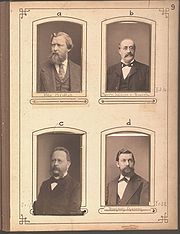
Julius Arnold
Encyclopedia

Zürich
Zurich is the largest city in Switzerland and the capital of the canton of Zurich. It is located in central Switzerland at the northwestern tip of Lake Zurich...
. He was the son of anatomist Friedrich Arnold
Friedrich Arnold
Friedrich Arnold was professor emeritus of anatomy and physiology at Heidelberg. He read medicine at the University of Heidelberg at the same time as his elder brother Johann Wilhelm Arnold ....
(1803–1890).
He studied medicine at the Universities of Heidelberg, Prague
Charles University in Prague
Charles University in Prague is the oldest and largest university in the Czech Republic. Founded in 1348, it was the first university in Central Europe and is also considered the earliest German university...
, Vienna
University of Vienna
The University of Vienna is a public university located in Vienna, Austria. It was founded by Duke Rudolph IV in 1365 and is the oldest university in the German-speaking world...
and Berlin, where he was a student of Rudolf Virchow
Rudolf Virchow
Rudolph Carl Virchow was a German doctor, anthropologist, pathologist, prehistorian, biologist and politician, known for his advancement of public health...
(1821–1902). In 1859 he became a doctor of medicine, and in 1866 he became a professor of pathological anatomy and director of the institute of pathology at Heidelberg
Heidelberg
-Early history:Between 600,000 and 200,000 years ago, "Heidelberg Man" died at nearby Mauer. His jaw bone was discovered in 1907; with scientific dating, his remains were determined to be the earliest evidence of human life in Europe. In the 5th century BC, a Celtic fortress of refuge and place of...
. Arnold was the author of 120 articles in the fields of histology
Histology
Histology is the study of the microscopic anatomy of cells and tissues of plants and animals. It is performed by examining cells and tissues commonly by sectioning and staining; followed by examination under a light microscope or electron microscope...
and pathological anatomy.
His name is lent to a disorder known as Arnold-Chiari malformation
Arnold-Chiari malformation
Arnold–Chiari malformation, or often simply Chiari malformation, is a malformation of the brain. It consists of a downward displacement of the cerebellar tonsils through the foramen magnum , sometimes causing non-communicating hydrocephalus as a result of obstruction of cerebrospinal fluid outflow...
, which occurs when the cerebellar tonsils and the medulla oblongata
Medulla oblongata
The medulla oblongata is the lower half of the brainstem. In discussions of neurology and similar contexts where no ambiguity will result, it is often referred to as simply the medulla...
protrude through the foramen magnum into the spinal canal
Spinal canal
The spinal canal is the space in vertebrae through which the spinal cord passes. It is a process of the dorsal human body cavity. This canal is enclosed within the vertebral foramen of the vertebrae...
. Arnold described this malformation in an infant who died shortly after delivery, and published his account in an 1894 paper titled Myelocyste, Transposition von Gewebskeimen und Sympodie. In 1891, Austrian pathologist Hans Chiari
Hans Chiari
Hans Chiari was an Austrian pathologist who was a native of Vienna. He was the son of gynecologist Johann Baptist Chiari , and brother to rhinolaryngologist Ottokar Chiari ....
(1851–1916) also described this disorder, three years prior to Arnold's findings. In 1907, two of Dr. Arnold's students coined the eponym of "Arnold-Chiari malformation" in honor of both men.

